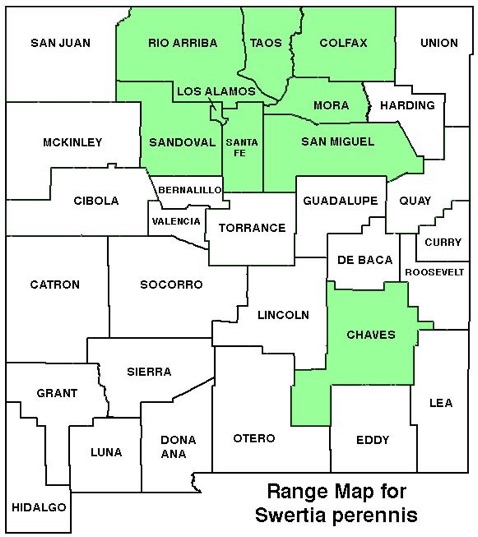WILDFLOWERS OF NEW MEXICO

Stout, unbranching stems 4–18 inches tall are lined with purple star-like flowers, and form colonies in lush, wet, mountain areas. Note the large basal leaves and smaller, opposite stem leaves, and the flowers are not tubular.
FLOWER: July–September. Purple flowers opening to 1 inch wide (25 mm) have 4 or 5 narrow, petal-like lobes separated to the base (not tubular), and streaked with dark veins; the two dark nectar pits at the base of each petal are often fringed with short hairs; slender, green sepals show between the petals; the prominent stamens are purple; pistil is swollen and tipped with a pointed style.
LEAVES: Basal, with stems (petioles) equal to or longer than the blade; blade elliptic to oval, 2 3/4–4 inches long (7–10 cm). Stem leaves opposite, lance-shaped, stemless, well-separated along the stem, much smaller than basal leaves.
HABITAT: Wet soil; bogs, marshy areas, stream sides, wet meadows and hillsides; montane, spruce-fir forests, alpine meadows.
ELEVATION: 8,000–11,800 feet.
RANGE: AZ ,CA, CO, ID, MT, NM, NV, OR, UT, WA, WY.
SIMILAR SPECIES: The dark-purple flowers with narrow, separate, spreading lobes (not united into a tube with lobes), and large basal leaves help distinguish this from other mountain species in the Gentian family.
NM COUNTIES: High mountains of northern NM and Chaves County in high-elevation, wet habitats: Chaves, Colfax, Los Alamos, Mora, Rio Arriba, San Miguel, Santa Fe, Sandoval, Taos.









STAR GENTIAN
SWERTIA PERENNIS
Gentian Family, Gentianaceae
Perennial herb


















THE CONTENTS OF THIS WEBSITE ARE COPYRIGHTED AND CANNOT BE USED
WITHOUT PERMISSION OF GEORGE OXFORD MILLER
















EMAIL ME



















• Prominent purple stamens (upper arrow).
• Paired nectar pits at the base of each petal (lower arrow).
Flower clusters and leaves are separated along a single, unbranching stem.


















